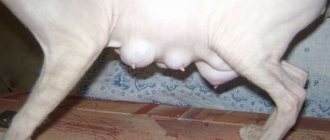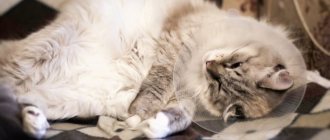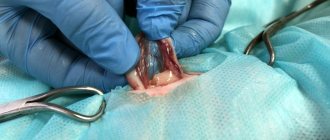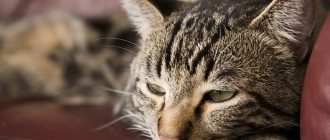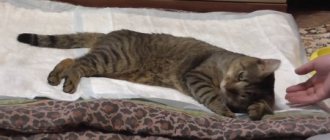Day of surgery: care options
After sterilizing a cat, the owner can take the animal home or leave it under observation at a veterinary clinic for a period of 1–10 days.
Leave in hospital
If the cat's owner does not have the opportunity to independently care for a sterilized cat, then he can leave it at the clinic.
The advantage of this solution is round-the-clock care and supervision of qualified specialists; the owner does not have to give injections, administer pills, or treat the seam on his own.
However, this decision will require a serious approach to choosing a veterinary clinic and quite large expenses for maintaining a pet.
Reference!
If the cat has health problems, then it must be kept under the supervision of veterinarians for the first days after the operation.
Way home
If the owner decides to independently care for the cat after surgery, then it is necessary to take into account many subtleties when transporting the animal home. The animal will be handed over in an unconscious state, wrapped in a postoperative blanket (bandage), which will protect the stitches from licking by the cat. Before leaving the clinic, the owner must:
- be sure to make sure that the doctor gives an anesthetic injection after the operation;
- listen to recommendations about postoperative care;
- make sure there is no bleeding from the suture.
After sterilization, a cat’s body temperature drops significantly, so it is very important, especially during cold periods, to wrap it in something warm and place it in a spacious basket or special carrier, having previously laid warm bedding on the bottom.
The cat should be placed on its right side, this will reduce the load on the heart and allow vomit to come out freely, preventing it from entering the respiratory tract.
Important!
Under no circumstances should you carry a cat in your arms, as it may recover from the anesthesia and escape in an inadequate state, which can lead to unpleasant consequences.
How to calm down?
As soon as the cat begins to come to its senses, it may have an inadequate reaction to sounds, movements, and coordination will be impaired; it may take off and quickly move in any direction.
Reference!
The cat may wake up 3-6 hours after surgery, depending on its body and the anesthetic drug.
You should not try in every possible way to calm the animal, since unnecessary attention in such a state will only worsen the situation. Therefore, it is best to isolate the cat in a completely enclosed area until it regains full control of its body, usually 4 to 12 hours.
Alternative methods
If the cause of the pain is not so serious, but at the same time you want to help your pet, you can resort to alternative methods that do not involve taking medications.
- Magnet therapy . This is a type of physical therapy. Veterinary medicine began to use it relatively recently. Magnets will help relieve inflammation and relieve pain. The procedure can only be performed in a veterinary office. Special plates are fixed to an area of the animal’s body, which are removed after some time.
- Homeopathy . In some cases, herbal remedies also bring good results. Travmatin is often recommended for cats. It is available in the form of tablets and drops. The product can even be used on kittens.
- Compresses . This is a pain reliever. It is important that the pain is not inflammatory in nature, otherwise you risk aggravating the situation.
- Manual therapy . Massage helps increase blood flow. The tissues receive proper blood supply. The body fights pain and drowns it out on its own. However, massage must be done correctly so as not to harm the cat. Not every animal will lie quietly during the manipulations you perform.
Massage helps cope with pain
Cat placement
Upon arrival home, the cat must be placed on the floor on soft bedding, laying it on its right side. It is necessary to put her on the floor to avoid falling from a height when she comes to her senses.
Important!
It is advisable to choose a waterproof bedding, since a cat under anesthesia cannot control itself and involuntary defecation may occur.
The room should be free of drafts, sharp objects and especially open windows, since, recovering from anesthesia, the cat is able to move quite quickly, in an uncontrolled state, not noticing obstacles in front of it, and jump out of the window.
In a state of anesthesia, cats do not close their eyes, so in order to avoid drying out the membranes of the eyes, the owner needs to drip them with a special solution and periodically open and close their eyes every 20 - 30 minutes until the animal regains consciousness.
How to do it right
A good veterinary clinic with competent doctors will never give you a cat after surgery without reviving it from anesthesia.
The few hours after surgery are the most difficult for both the animal itself and the person caring for it. The cat will not only sleep, she may pee under herself, she may start vomiting, her temperature may drop below normal, and other unforeseen consequences may also arise. After 1-2 hours she will wake up - and it will become even more difficult: the cat will try to walk, but there will be problems with orientation, as a result she will begin to stagger, fall, try to jump somewhere, etc. At this time, the animal needs special care and the possibility of urgent assistance from a veterinarian. That is why good clinics will never give a cat to the owner in a state of anesthesia, but will tell him to come back in a few hours and give him a more or less coordinated animal, which has been given an antibiotic and painkiller, and also put on a blanket to protect the seam.
The cat, after the doctors have brought it out of anesthesia, will also be a little inadequate in its movements, but it will be quite able to drink, eat and go to the toilet on its own.
Going to the toilet
After sterilization, cats may have difficulty meeting their physiological needs for some time.
This may be due to both the body’s reaction to the operation and a symptom of complications. Typically, a cat may not go to the toilet for one day, but if this problem lasts more than a day, then it is necessary to seek help from a veterinarian. Several signs will also help you understand what the problem is.
- Has the cat consumed any liquids? If not, then there should be no reason for concern either, since the animal simply does not need to go small.
- The postoperative blanket initially causes great discomfort for the animal, which may cause the animal not to want to go to the toilet.
- Since after the operation the animal is in a fairly weakened state, it can gradually excrete a small amount of urine, which is difficult for the owner to notice, which in turn eliminates any cause for concern.
Reference!
Constipation can be a common phenomenon, since all processes in the cat's body are inhibited due to anesthesia.
What are the best painkillers to give to cats?
The final decision on which drug should be used for your pet must be made by the veterinarian who carries out the examination and collects tests. Most often, if opportunity allows, the doctor opts for non-narcotic drugs.
However, if a serious surgical intervention takes place or the animal is in a state of shock from the sensations experienced, the choice is made in favor of morphine-based drugs.
The final decision on the choice of drug should always be made only by the doctor.
When choosing a particular drug, the doctor is based on the following factors.
- Age of the animal.
- Nature of pain.
- Her reason.
- Animal weight.
- The behavior of the animal at the time of inspection.
- Duration of illness.
- Specifics of the situation.
- Test results.
Feeding
When to feed and water?
A sterilized cat that has recovered from anesthesia does not need to be fed, but only carefully given water through a syringe, watching its sips, otherwise the cat may choke.
On the first day, the pet will most likely be indifferent to eating, so you should not force it. And starting from the second day, you can offer her a third of her usual portion.
Nutrition
Food for sterilized cats should be low-fat and easily digestible by the body. In the first days you can offer her:
- vegetable broth;
- baby food
- special food for sterilized animals;
- low-fat dairy products.
A few days after surgery, the cat will begin to show interest in food. Portions can be gradually increased, but it is better to reduce the daily food intake, since sterilized cats have a tendency to become obese.
In the subsequent days of the sterilized cat’s life, the owner needs to decide what to feed the animal:
- Industrial food for sterilized animals.
- Natural food.
In the first option, the owner needs to be careful when choosing quality food, since sterilized cats are prone to urolithiasis. It is best to seek advice from a veterinarian when choosing industrial food.
The best nutrition option for your pet is a balanced diet made from natural products. For example:
- lean meat;
- semolina;
- raw fish;
- low-fat dairy products;
- potatoes and beans.
Salted, fried and smoked foods should be excluded from the diet, as they disrupt metabolism.
Important!
It is prohibited to mix industrial feed and natural food.
Painkillers
The first days after surgery are the most difficult, and various painkillers will help your pet cope with pain.
If there are no veterinary drugs at hand, Analgin may be suitable. Despite the fact that Analgin is not intended for animals, it is perfect for relieving severe pain. Only a veterinarian can prescribe the correct dosage, usually no more than 0.5 g.
There are also special veterinary drugs available. For example, Tolfedin, Ketofen, Ainil, Previcox, Loxicom and others. Usually taken once a day, one tablet or one injection, depending on the drug.
Important!
It is strictly forbidden to use paracetamol or other human medications for pain relief. This will be fatal!
Depending on the animal's pain threshold, the effect of the painkiller may wear off after 10 hours. The cat will feel unwell and may behave aggressively, and to avoid this, it is allowed to re-give the cat a third of the dose of the drug.
Types of painkillers
In veterinary practice, all painkillers that are allowed for use by animals are divided into two large groups. These are narcotic drugs and non-narcotic painkillers.
| View | Image | Description |
| Narcotic analgesics | The main active ingredient in the composition is opioids or morphine. The action is manifested in a strong analgesic effect, the animal ceases to feel itself in reality. The main effect is directly on the central nervous system. The pain center in the brain is simultaneously blocked. Narcotic analgesics not only reduce pain, but are also a good hypnotic and sedative. However, frequent use can lead to disastrous results. | |
| Non-narcotic drugs | The most commonly used drugs in veterinary practice. They cope well with moderate to mild pain. Often used for inflammation of the joints and diseases of the gastrointestinal tract. Much safer than drugs. The drugs are quickly eliminated from the body. Short-term effect |
Important! Your pet is very sensitive to medications. Therefore, it is necessary to give him this or that painkiller only under the supervision of a veterinarian and on his instructions. If you incorrectly calculate the dose at the time of administration, dangerous consequences may occur, including death.
Antibiotics
Why give them?
Antibiotics are usually used to prevent and control infectious diseases.
As for humans, they are a last resort. Veterinarians believe that after a sterile operation, a cat does not require a long course of antibiotics.
Since antibiotics are quite hard on the health of the body, the veterinarian only gives one injection after surgery, but they may be prescribed in the following days.
Drugs
In modern veterinary medicine there are many different antibiotics. They all have their positive and negative sides. Antibiotics are usually introduced into the body in the form of injections, since it is impossible to give a pill to a cat under anesthesia.
The most common drugs are:
- amikacin;
- amoxicillin;
- ceftricasone;
- sinulox;
- cefazolin;
- gentamicin.
The dosage and type of antibiotic are prescribed only by a veterinarian individually, depending on the animal’s health condition.
How to offer a cat a pill?
It’s great if the drug is prescribed in the form of injections. All you have to do is visit the veterinarian at the appointed time and get an injection. The procedure is painful, but simple to perform. But what to do if the painkiller is only available in tablets, and you need to offer it to your cat?
How to give a cat a pill
There are several methods you can use.
- First, decide on the dosage. This can be a whole tablet, half or a third of it.
- Once you have determined the required amount of the drug, cut it off the tablet if necessary.
- Press the tablet several times with a knife. It breaks into several small pieces.
- Take your cat's favorite treat. Perhaps it's a piece of sausage or cheese. Offer the animal a treat. Most often, cats eat what is offered along with the medicine.
However, there are picky individuals. If the cat spits out pieces of the tablet, it is necessary to crush the required dosage in a mortar. After this, you need to dissolve the powder in water and try to pour it down your pet’s throat. This can be done with a syringe.
Many owners who have failed with the above methods mix liquid cat food with powder.
Do not give the animal a whole tablet or large pieces of it. Most likely, the cat will not be able to chew them properly, something will cause a gag reflex, or it will clog her stomach.
Video - How to simplify the process of giving pills to cats
Seam processing
Suture treatment should be carried out starting from the second one after the operation.
For this purpose, antiseptics are used - a solution of chlorhexidine or miramistin. Treatment consists of daily wiping the seam with a swab containing an antiseptic. In this case, it is imperative to remove adhering hair and remnants of suture secretions from the wound.
After treatment, it is recommended to lubricate the seam with a healing ointment; Levomekol is ideal. The wound must be dressed for 10 days.
Seam processing
Bleeding from postoperative sutures should not be allowed. More than 2 drops of blood cannot be released from a suture per day; this should not be confused with ichor, which looks like blood diluted in water.
Bleeding from postoperative sutures should not be allowed.
The condition of the seam may include redness, blood stains (small bruises), and the skin itself may be swollen. There is nothing wrong with this, these are consequences after surgery.
On a note! You can look at the condition of the suture no earlier than 5 days after the operation, if the skin around the suture is moist, the sutures and skin around it are treated with antibacterial ointments.
Jumping: when can you start and how to stop it?
On the fifth or sixth day after surgery, the cat will be able to begin to show sufficient activity and can be released indoors, allowing it to take relatively short walks and jump on low surfaces. During this time, the cat should always be supervised so that it does not try to remove the blanket or get caught on anything.
Preventive measures
Before sterilizing a cat, you need to make sure that it is completely healthy, vaccinated and disinfected against worms.
Vaccination
If you sterilize an unvaccinated cat, then it will have a high risk of contracting an infection, so veterinarians recommend making sure to take care of the vaccine. The vaccination is usually given at least three weeks before surgery.
Treatment for worms
For cats that are often outdoors, deworming every three months is recommended. The cat must be dewormed 10 days before sterilization, but if the previous treatment was carried out at least a month ago, then the animal does not need an additional procedure.
A reminder to the cat owner about proper care of the animal
Below is a list of steps to keep in mind after spaying your cat.
- Carefully transport the animal, place it in a box or carrier to avoid injury to the pet.
- If the cat wants to go to the toilet, put it on the potty, then take it back to the box.
- Water can be given from a finger. If the cat opens to drink, you can offer tea.
- In the evening, you need to give an anesthetic, as the pain may return. Also don't forget to give an antibiotic.
- You can try to feed the cat a little. If she refuses, be sure to at least give her a drink of water.
- The next day, you should also not forget about painkillers and antibiotics. Keep an eye on the cat, the animal should already be hungry, so be sure to offer it food. Be sure to treat the wound.
- For the next 3 days, continue to give pain medication morning and evening, and antibiotics if necessary.
- Do not allow your pet to jump for 5-7 days after surgery.
- For 10 days after surgery, you need to treat the wound every day and do not remove the blanket.
Reference!
The above steps may be modified depending on the type of sterilization. This memo is for the standard view.
Sterilization itself is not a complicated operation, and caring for the animal after it requires quite a lot of effort and increased attention. It is necessary to follow the instructions of the veterinarian and, at the slightest concern, seek his help. Then the cat will easily endure all the difficulties of the postoperative period without any complications.
What do veterinarians advise for care?
When it comes to caring for a cat after sterilization, veterinarians’ advice boils down to the following points:
- Clean the tray after each visit. During the recovery period, it is better to make do with pieces of paper.
- Strictly exclude any water procedures. During this period, use wet wipes. You can bathe after the seam is completely closed.
- It is necessary to isolate the cat from other relatives and especially dogs.
- Monitor her bouts of activity - this threatens the sutures coming apart.
- No antibiotics are required. The surgeon gives one injection during the operation.
- If the operation was carried out as usual and the animal is in good health, then the use of vitamins is not required.
- Hemostatic drugs are needed only in case of poor blood clotting.
- Veterinarians advise getting a preventive vaccination. Especially if you are planning to have surgery in a clinic.
